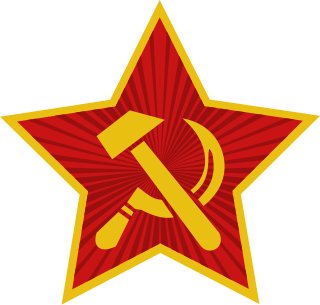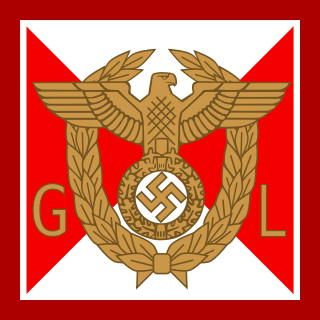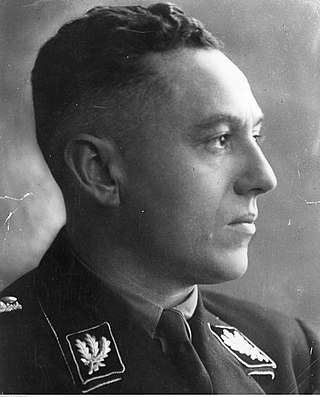
The Nazi Party, officially the National Socialist German Workers' Party, was a far-right political party in Germany active between 1920 and 1945 that created and supported the ideology of Nazism. Its precursor, the German Workers' Party, existed from 1919 to 1920. The Nazi Party emerged from the extremist German nationalist, racist and populist Freikorps paramilitary culture, which fought against the communist uprisings in post–World War I Germany. The party was created to draw workers away from communism and into völkisch nationalism. Initially, Nazi political strategy focused on anti–big business, anti-bourgeois, and anti-capitalist rhetoric, which was later downplayed to gain the support of business leaders. By the 1930s, the party's main focus shifted to antisemitic and anti-Marxist themes. The party had little popular support until the Great Depression, where worsening living standards and vast unemployment drove Germans into political extremism.
Neo-Nazism comprises the post–World War II militant, social, and political movements that seek to revive and reinstate Nazi ideology. Neo-Nazis employ their ideology to promote hatred and racial supremacy, attack racial and ethnic minorities, and in some cases to create a fascist state.
The Sturmabteilung was the original paramilitary wing of the Nazi Party. It played a significant role in Adolf Hitler's rise to power in the 1920s and 1930s. Its primary purposes were providing protection for Nazi rallies and assemblies, disrupting the meetings of opposing parties, fighting against the paramilitary units of the opposing parties, especially the Roter Frontkämpferbund of the Communist Party of Germany (KPD) and the Reichsbanner Schwarz-Rot-Gold of the Social Democratic Party of Germany (SPD), and intimidating Romani, trade unionists, and especially Jews.

Ernst Julius Günther Röhm was a German military officer and an early member of the Nazi Party. As one of the members of its predecessor, the German Workers' Party, he was a close friend and early ally of Adolf Hitler. Röhm played an indispensable role in the early years of the Nazi Party as he used his World War I connections to grow the Sturmabteilung, the Nazi Party's militia, which he co-founded. Röhm was eventually made leader of the SA and led a campaign of political violence during the Nazis' rise to power. His relationship with Hitler began to deteriorate once the Nazis seized national power in 1933. As the Nazi government began securing itself, the tension between Hitler and Röhm escalated. Throughout 1933, Röhm attempted to obtain more power for the SA, which the German Army saw as a growing threat to their position. Hitler came to see Röhm as a potential rival and decided to eliminate him. Röhm was executed by the SS in 1934 during the Night of the Long Knives.

Wilhelm Frick was a prominent German politician of the Nazi Party (NSDAP), who served as Minister of the Interior in Adolf Hitler's cabinet from 1933 to 1943 and as the last governor of the Protectorate of Bohemia and Moravia.

The Hitler Youth was the youth organisation of the Nazi Party in Germany. Its origins date back to 1922 and it received the name Hitler-Jugend, Bund deutscher Arbeiterjugend in July 1926. From 1936 until 1945, it was the sole official boys' youth organisation in Germany and it was partially a paramilitary organisation. It was composed of the Hitler Youth proper for male youths aged 14 to 18, and the German Youngsters in the Hitler Youth for younger boys aged 10 to 14.
Führer is a German word meaning "leader" or "guide". As a political title, it is strongly associated with the Nazi dictator Adolf Hitler, who officially styled himself der Führer und Reichskanzler after the death of President Paul von Hindenburg and the subsequent merger of the offices of Reichspräsident and Reichskanzler.

The Communist Party of Germany was a major political party in the Weimar Republic between 1918 and 1933, an underground resistance movement in Nazi Germany, and a minor party in West Germany in the postwar period until it was banned by the Federal Constitutional Court in 1956.

The German American Bund, or the German American Federation, was a German-American Nazi organization which was established in 1936 as a successor to the Friends of New Germany. The organization chose its new name in order to emphasize its American credentials after the press accused it of being unpatriotic. The Bund was allowed to consist only of American citizens of German descent. Its main goal was to promote a favorable view of Nazi Germany.

A Gauleiter was a regional leader of the Nazi Party (NSDAP) who served as the head of a Gau or Reichsgau. Gauleiter was the third-highest rank in the Nazi political leadership, subordinate only to Reichsleiter and to the Führer himself. The position was effectively abolished with the fall of the Nazi regime on 8 May 1945.

Strasserism is a strand of Nazism calling for a more radical, mass-action and worker-based form of the ideology, espousing economic antisemitism above other antisemitic forms, to achieve a national rebirth. It derived its name from Gregor and Otto Strasser, two brothers initially associated with this position.
This is a list of words, terms, concepts and slogans of Nazi Germany used in the historiography covering the Nazi regime. Some words were coined by Adolf Hitler and other Nazi Party members. Other words and concepts were borrowed and appropriated, and other terms were already in use during the Weimar Republic. Finally, some are taken from Germany's cultural tradition.

Bruno Streckenbach was a German SS functionary during the Nazi era. He was the head of Administration and Personnel Department of the Reich Security Main Office (RSHA). Streckenbach was responsible for many thousands of murders committed by Nazi mobile killing squads known as Einsatzgruppen.

Albert Maria Forster was a Nazi German politician, member of the SS and war criminal. Under his administration as the Gauleiter and Reichsstatthalter of Danzig-West Prussia during the Second World War, the local non-German population of Poles and Jews was classified as sub-human and subjected to extermination campaign involving ethnic cleansing, mass murder, and in the case of some Poles with German ancestry, forceful Germanisation. Forster was directly responsible for the extermination of non-Germans and was a strong supporter of Polish genocide, which he had advocated before the war. Forster was tried, convicted and hanged in Warsaw for his crimes, after Germany was defeated.

Ranks and insignia of the Nazi Party were paramilitary titles used by the National Socialist German Workers' Party (NSDAP) between approximately 1928 and the fall of Nazi Germany in 1945. Such ranks were held within the political leadership corps of the Nazi Party, charged with the overseeing of the regular Nazi Party members.

The National Party of Australia – N.S.W., commonly known as "The Nationals" or the NSW Nationals, is a political party in New South Wales which forms the state branch of the federal Nationals and has traditionally represented graziers, farmers, and rural voters generally.
Friends of New Germany, sometimes called Friends of the New Germany, was an organization founded in the United States by German immigrants to support Nazism and the Third Reich.
Conservatism in Germany has encompassed a wide range of theories and ideologies in the last three hundred years, but most historical conservative theories supported the monarchical/hierarchical political structure.











